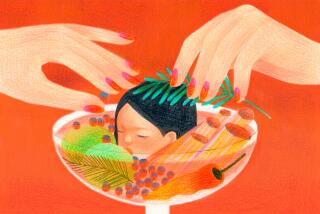Exotic flavors bubble up in diet soda market
It’s been 60 years since diet soda first burst on the scene with a sugar-free ginger ale known as No-Cal that catered to diabetics. Then came RC Cola’s Diet Rite, followed by Tab, Fresca and a slew of sugar-free versions of Pepsi and Coca-Cola that seem to be in perpetual states of reformulation to accommodate customers’ fickle tastes.
Today, it isn’t just colas that are going on a diet. The market for no-calorie sodas has become as effervescent as the beverages themselves, with an ever-expanding palette of exotic flavors such as coconut, pomegranate and coffee — many of them from small companies that are developing loyal followings catering to customers’ thirst for carbonated indulgence without the sugar.
“We’d all love to drive a Ferrari if it had the fuel consumption of a Prius, but you can’t have it all. What we’ve found with our product is that it gets the fuel consumption of a Prius and maybe drives like a BMW,” said Paddy Spence, chief executive of Zevia, a brand of stevia-sweetened sodas based in Culver City that is sold locally at Whole Foods, Ralphs and some Targets, among other stores.
Zevia was the first carbonated drink company to use the natural, no-calorie sweetener derived from the leaves of the Stevia rebaudiana plant, which is generally recognized as safe by the U.S. Food and Drug Administration for use as a sweetener in foods. Stevia is more commonly used in non-carbonated beverages, such as Sobe Life Water and Vitamin Water Zero.
Most diet sodas are artificially sweetened with aspartame (better known as NutraSweet or Equal), acesulfame potassium (also known as Ace-K) or sucralose (branded as Splenda) — sometimes in combination. All of them are artificial sweeteners produced using chemical processes that are regulated by the FDA as food additives. All of them offer more concentrated levels of sweetness than ordinary table sugar without the calories.
The FDA has approved the use of five artificial sweeteners as food additives, including aspartame, Ace-K and sucralose, as well as saccharin and neotame. Before each sweetener came to market, the FDA determined it was safe “well within acceptable daily intake levels,” said FDA spokeswoman Carla Daniels.
While some studies have shown that repeated exposure to low- and no-calorie sweeteners may lead to the development of preferences for sweet foods and beverages and high-calorie foods, and eventually lead to health complications associated with such a diet, that hasn’t slowed the market. Diet soda is a rare sweet spot in the carbonated soft-drink business. Sales of soda overall have been declining in the U.S. since 2005 as consumers migrate to other types of bottled drinks, such as water and tea. In 2000, diet sodas made up 24.7% of the crowded $76-billion carbonated beverage market in the U.S. Driven by consumers’ demand for sweet drinks without the weight gain and tooth decay associated with 160-calories-per-can sugar versions, diet sodas now make up 29.1% of sales, according to John Sicher, editor and publisher of Beverage Digest in Medford Hills, N.Y.
Galco’s Soda Pop Stop in L.A.’s Highland Park neighborhood carries almost two dozen types of diet soda, such as Fitz’s of St. Louis, Boylan of New Jersey and Hank’s of Trevose, Pa., as well as Lorina from France and Squamscot from New Hampshire. Among the flavors he carries are diet sodas in grape, chai and vanilla, as well as more traditional flavors, such as cola and citrus.
“People want to taste something different, and that’s what we’re about,” said John Nese, owner of Galco’s for 15 years. “Some of those people want zero calories.”
More to Read
Sign up for The Wild
We’ll help you find the best places to hike, bike and run, as well as the perfect silent spots for meditation and yoga.
You may occasionally receive promotional content from the Los Angeles Times.









